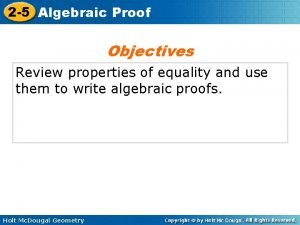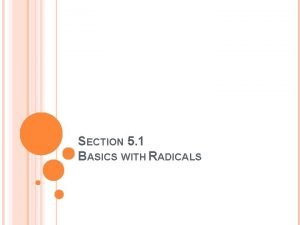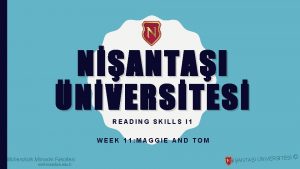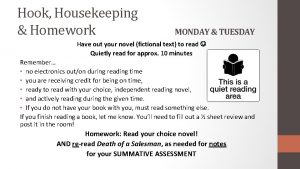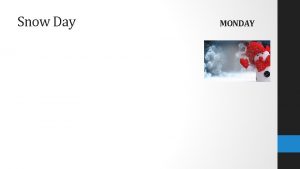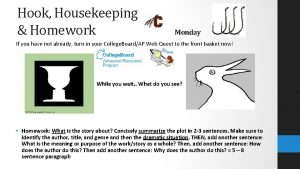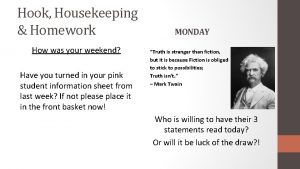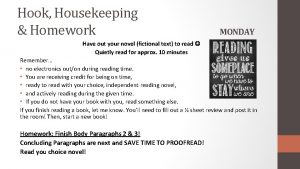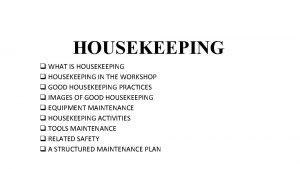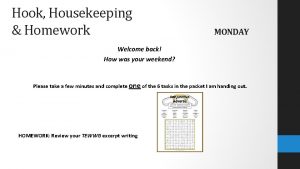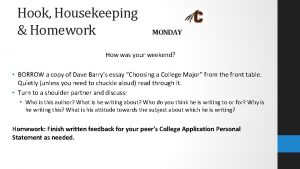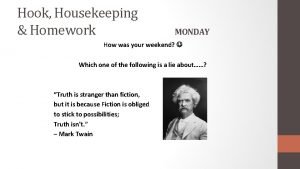Hook Housekeeping Homework MONDAYSnow Day TUESDAY Have a



















- Slides: 19

Hook, Housekeeping & Homework MONDAY=Snow Day - TUESDAY Have a seat anywhere, but don’t get to comfortable because I will be putting you in or out of the fishbowl (if we have 2/3 of the class) Homework: • Observation Form (pink) & Written Response (250 -300 words) due Wednesday (or before)! • Oral Communication Self-Assessment (pink) & any additional notes are due Tuesday (tomorrow) • Because of the snow day, all forms & written work are due no later than Friday. Keep in mind, you need to be here for both discussions in order to receive both grades! If you do not participate in the summative fishbowl discussion assignments (oral discussion and observation listening), you cannot earn credit for the class. If you are absent, you must come in for a make-up discussion (lunch Wednesday). Read your choice novel!

Past, Present, Future MONDAY=Snow Day - TUESDAY • Summative Fishbowl Assignments & Preparation • Read, view, and take notes • Class goal • Parent/Teacher Conferences • Snow Day • SUMMATIVE: Fishbowl Discussion • ALL 4 Critical Lenses – written notes • Death of Salesman Act 2 & Requiem • Make-up at lunch Wednesday, only, unless • 2 nd half of SUMMATIVE: Fishbowl Discussion • Read your choice novel

Short Stories Through a Critical Lens MONDAY Standards 1. Oral Communication and Listening 2. Reading for All Purposes 1. Literary criticism of complex texts requires the use of analysis, interpretive, and evaluative strategies Objective: you will be able to show what you know about examining a play through various lenses by participating in a fishbowl discussion and observation Relevance: • By interpreting complex texts, providing evidence, and communicating ideas, we are not only practicing the skills need in any workplace or postsecondary setting, but also we are examining aspects of ourselves and others and how these as well as social and historical events impact the way in which we communicate. • By learning to examine situations from different perspectives, we open ourselves to recognizing, understanding, explaining, and judging the ways in which we, as well as others, conduct ourselves, in order to more productively function in an every changing world. Inquiry Questions: • What is critical theory? What is a critical lens? What are five types of critical lenses? • What archetypes exist in this text, and how do they work to create a broader purpose? • How would a feminist/gender critic approach and respond to this text? • How would a Marxist/social class critic approach and respond to this text? • How would a psychoanalytical/psychological critic approach and respond to this text? • How would a historical/biographical critic approach this text? • How do readers utilize critical lenses to create different interpretations of the writer’s craft? How do reader’s perspectives differ depending on a specific critical lens? Which critical lens is most useful/powerful to understanding the story as a whole?

Activity: Summative Assessment Purpose: to show what you know about examining a play through various lenses by participating in a fishbowl discussion and observation Tasks: 1. Create a fishbowl 2. If you are observing, check with your assigned “partner. ” Have you spelled their first and last name correctly? 1. Check with your partner for the following items and check them off on your form: • A COPY OF THE PLAY + or 0 • WRITTEN NOTES = REPSONSES TO LENSES OR OR 0 • OTHER WRITTEN RESPONSES = Hist/Bio Research, COMPLETED Reading Guide Questions and/or Character ID chart OR OR 0

Activity: Summative Assessment Purpose: to show what you know about examining a play through various lenses by participating in a fishbowl discussion and observation Tasks: Let’s get started! “Through a ______ lens, the reader would think _____ (POINT). For example, in the story on page ___ when ______ (ILLUSTRATION). This shows that ____________ (EXPLAINATION) and that _____________ (ELABORATE on seeing the story through this perspective (lens) and/or it significance to the story over all. Outcome: Plus/Delta – Review & Release (see next)

Models: Oral Communication Self-Assessment I was thinking that while their friend was seen as rich maybe she was rich because she bought “knock offs” instead of spending all her money on jewelry or other material items! This could relate to a theme discussed about not seeing people as they really are; wealth and class are an illusion. I would have added that if she would not have rushed out of the ball because of her shabby coat, she may not have lost the necklace. Through a Marxist lens, this shows that when we are more concerned about our material, outward appearances, it can cause dire consequences. I wanted to talk about how I was mad that women were shown to be greedy, selfish and even snotty (M Foriester at the end) in the story. It seemed like no one was offended by this portrayal. On the other hand, I think Mathilda represents the desires most of us have to move up in social ranking. This story seems to show that this is not possible, though.

Models: Fishbowl Observation Written Response The person I observed brought up looking at “The Necklace, ” the short story discussed, through a feminist lens because they were examining how the women were portrayed in the story. The group started to compare the short story “The Story of an Hour” to the discussion story, “The Necklace. ” They noted that both stories primarily relate a female perspective. Tom Terror said that both women were “trapped” in a marriage because of the time period, both in the 1800 s, but that “The Necklace” focused more on material greed and social pride (as compared to self-fulfillment). Another group member shared a quote to support this from the second page about Mathilda’s desire to fit in, that she would “look like distress” and that there is nothing worse than looking poor among the rich. The group tended to agree with the idea of social acceptance being a big part of the story, but it seemed like a lot of them tended to “bash” Mathilda for her greed and her husband for not having a backbone. They noted that he kept trying to solve her problems which only encouraged her insecurities. I noticed, though, that the husband was saving for a material item, too, the gun. I also feel like it would be natural for a husband to want to “do right” for his wife who feels inadequate – just like we may want to look good at prom and talk our parents into spending too much money. While I think the author’s focus was power and social class (Marxist lens), I realized that looking at this from a feminist lens is important, too. It seems like women are shown to be more self-centered and about “appearances” – even Mathilda’s friend who loaned her the necklace – than men. Thus, unlike “The Story of an Hour, ” it does not show a very positive side of women because it shows Mathilda to be weak, insecure, and reliant on her husband. My partner did not speak, but the girl next to her looked at the story through a Marxist lens. She noted how the Loisels were middle class at the beginning. This was helpful because many people discussed how poor they were, but she pointed out they didn’t actually experience true poverty until the necklace was lost, and they went into debt. She pointed to the text evidence that showed before the loss, they actually had a servant, and he had a job and the ability to save (vs. pay back) money for a gun. I would have added that the author also included the fact that Mathilda became less beautiful after all the hard work. This shows that being in the lower class had not only monetary implications but also physical implications. I think this was the main point of the story, that poverty takes its toll in many ways on people. I also was thinking that all the people at the ball noticed her when she was dressed up etc. Was this because appearances matter to them, too? The author commented that she noted for her beauty. But, maybe she was more self-assured so she stood out more to others? Regardless, people in poverty have it pretty rough, so appreciate what you have!

Review & Release Homework: • Observation Form (pink) & Written Response (250 -300 words) due Wednesday (or before)! • Oral Communication Self-Assessment (pink) & any additional notes are due Tuesday (tomorrow) Keep in mind, you need to be here for both discussions in order to receive both grades! If you do not participate in the summative fishbowl discussion assignments (oral discussion and observation listening), you cannot earn credit for the class. If you are absent, you must come in for a make-up discussion (lunch Wednesday). • If you do not participate in the summative fishbowl discussion assignments (oral discussion and observation listening), you cannot earn credit for the class. • If you are absent, you must come in for the make-up discussion (lunch).

Hook, Housekeeping & Homework THURSDAY Have out your novel (fictional text) to read Quietly read for approx. 10 minutes Remember… • no electronics out/on during reading time • you are receiving credit for being on time, • ready to read with your choice, independent reading novel, • and actively reading during the given time. • If you do not have your book with you, must read something else. If you finish reading a book, let me know. You’ll need to fill out a ½ sheet review and post it in the room! Homework: YOUR SUMMATIVE WORK is DUE TOMORROW • Observation Form (pink) & Written Response (250 -300 words) • Oral Communication Self-Assessment (pink) • Read your choice novel!

Past, Present, Future THURSDAY • SUMMATIVE: Fishbowl Discussion • ALL 4 Critical Lenses – written notes • Snow Day Monday AND Wednesday • Choice Novel Reading Time and/or • Summative Fishbowl 1 Written Work Time (lab) • Death of Salesman Act 2 & Requiem • Make-up DISCUSSION at LUNCH FRIDAY 1 ST only, ROOM 125 • 2 nd half of SUMMATIVE: Fishbowl Discussion • Read your choice novel

Activities: Develop & Apply • Summative Fishbowl 1 Written Work Time (Lab 257) • See next for models • Prep for make-up discussion • Choice Novel Reading Time

Models: Oral Communication Self-Assessment I was thinking that while their friend was seen as rich maybe she was rich because she bought “knock offs” instead of spending all her money on jewelry or other material items! This could relate to a theme discussed about not seeing people as they really are; wealth and class are an illusion. I would have added that if she would not have rushed out of the ball because of her shabby coat, she may not have lost the necklace. Through a Marxist lens, this shows that when we are more concerned about our material, outward appearances, it can cause dire consequences. I wanted to talk about how I was mad that women were shown to be greedy, selfish and even snotty (M Foriester at the end) in the story. It seemed like no one was offended by this portrayal. On the other hand, I think Mathilda represents the desires most of us have to move up in social ranking. This story seems to show that this is not possible, though.

Models: Fishbowl Observation Written Response The person I observed brought up looking at “The Necklace, ” the short story discussed, through a feminist lens because they were examining how the women were portrayed in the story. The group started to compare the short story “The Story of an Hour” to the discussion story, “The Necklace. ” They noted that both stories primarily relate a female perspective. Tom Terror said that both women were “trapped” in a marriage because of the time period, both in the 1800 s, but that “The Necklace” focused more on material greed and social pride (as compared to self-fulfillment). Another group member shared a quote to support this from the second page about Mathilda’s desire to fit in, that she would “look like distress” and that there is nothing worse than looking poor among the rich. The group tended to agree with the idea of social acceptance being a big part of the story, but it seemed like a lot of them tended to “bash” Mathilda for her greed and her husband for not having a backbone. They noted that he kept trying to solve her problems which only encouraged her insecurities. I noticed, though, that the husband was saving for a material item, too, the gun. I also feel like it would be natural for a husband to want to “do right” for his wife who feels inadequate – just like we may want to look good at prom and talk our parents into spending too much money. While I think the author’s focus was power and social class (Marxist lens), I realized that looking at this from a feminist lens is important, too. It seems like women are shown to be more self-centered and about “appearances” – even Mathilda’s friend who loaned her the necklace – than men. Thus, unlike “The Story of an Hour, ” it does not show a very positive side of women because it shows Mathilda to be weak, insecure, and reliant on her husband. My partner did not speak, but the girl next to her looked at the story through a Marxist lens. She noted how the Loisels were middle class at the beginning. This was helpful because many people discussed how poor they were, but she pointed out they didn’t actually experience true poverty until the necklace was lost, and they went into debt. She pointed to the text evidence that showed before the loss, they actually had a servant, and he had a job and the ability to save (vs. pay back) money for a gun. I would have added that the author also included the fact that Mathilda became less beautiful after all the hard work. This shows that being in the lower class had not only monetary implications but also physical implications. I think this was the main point of the story, that poverty takes its toll in many ways on people. I also was thinking that all the people at the ball noticed her when she was dressed up etc. Was this because appearances matter to them, too? The author commented that she noted for her beauty. But, maybe she was more self-assured so she stood out more to others? Regardless, people in poverty have it pretty rough, so appreciate what you have!

Review & Release Homework: • Observation Form (pink) & Written Response (250 -300 words) • Oral Communication Self-Assessment (pink) Keep in mind, you need to be here for both discussions in order to receive both grades! If you do not participate in the summative fishbowl discussion assignments (oral discussion and observation listening), you cannot earn credit for the class. If you are absent, you must come in for a make-up discussion (lunch Wednesday). • If you do not participate in the summative fishbowl discussion assignments (oral discussion and observation listening), you cannot earn credit for the class. • If you are absent, you must come in for the Make-up DISCUSSION at LUNCH FRIDAY 1 ST only, ROOM 125

Hook, Housekeeping & Homework FRIDAY Have out your novel (fictional text) to read Quietly read for approx. 10 minutes Remember… • no electronics out/on during reading time • you are receiving credit for being on time, • ready to read with your choice, independent reading novel, • and actively reading during the given time. • If you do not have your book with you, must read something else. If you finish reading a book, let me know. You’ll need to fill out a ½ sheet review and post it in the room! Homework: Read your choice novel! AND Read Death of a Salesman, as needed FINISH ACT 2 NO LATER THAN WEDNESDAY

Past, Present, Future FRIDAY • Snow Day Monday AND Wednesday • Choice Novel Reading Time and/or • Summative Fishbowl 1 Written Work Time (lab) November Birthdays? ! Drama: Death of a Salesman • TURN IN THE FIRST ½ OF YOUR SUMMATIVE FB WORK; IF YOU WERE IN THE DISCUSSION CIRCLE PLEASE HAVE YOUR NOTES OUT IN FRONT OF YOU! • Review & Read Death of a Salesman • Use the Reading Questions to take notes and guide your understanding of the play • Make-up DISCUSSION at LUNCH FRIDAY 1 ST only, ROOM 125 Drama: Death of a Salesman • FINISH ACT 2 NO LATER THAN WEDNESDAY • Use the Character Identification Chart and the Reading Questions to take notes and guide your understanding of the play • View & Read Death of a Salesman • Use the reading packet to take notes and guide your understanding of the play • Consider the play through the 4 critical lenses for Summative Assessment (TWO FISHBOWL DISCUSSIONS & a full-length essay)

Drama Through a Critical Lens Standards 2. Reading for All Purposes 1. Literary criticism of complex texts requires the use of analysis, interpretive, and evaluative strategies Objective: to analyze the drama Death of a Salesman through the 4 critical lenses we’ve studied: historical/biographical, feminist, Marxist, and psychoanalytical. Relevance: • By interpreting complex texts, providing evidence, and communicating ideas, we are not only practicing the skills need in any workplace or postsecondary setting, but also we are examining aspects of ourselves and others and how these as well as social and historical events impact the way in which we communicate. • By learning to examine situations from different perspectives, we open ourselves to recognizing, understanding, explaining, and judging the ways in which we, as well as others, conduct ourselves, in order to more productively function in an every changing world. Inquiry Questions: What strategies are most useful when reading, understanding, making personal connections to, and analyzing texts ? What is critical theory? What do we ask ourselves when viewing a text through different lenses? How does one’s perspective influence the reading of a text? How does reading from a particular perspective influence what is seen as important within a text and how characters, events, and theme are understood? How is literature a voice of social commentary?

Activity: Develop & Apply We - You Do Purpose: to identify setting, characters, conflicts, and actions in the play Tasks: 1. Review: Reading Questions – What do you know so far? To what can you respond? 2. Read aloud from the drama Death of a Salesman • Pause periodically and discuss setting, characters, and rising action in the play • Use the Reading Questions to take notes and guide your understanding of the play Outcome: Continue to chart our characters (facts, attitudes, quotes) • Select quotes that reveal their attitudes and/or ones that a literary critic (psychanalytical, feminist, Marxist, hist. /bio) would be interested in. WRITE THE PAGE NUMBER

Review & Release What questions do you have about the play? FINISH ACT 2 NO LATER THAN WEDNESDAY Reminder: Summative assessments are also due on the due date for “full” credit because they, too, build on one-another; therefore, one summative must be completed before the next and all are needed to earn course completion. If a summative is turned in later than the specified due date, 10% of the total possible score will be deducted for each day it is late, up to 5 school days.
 Day 1 day 2 day 3 day 4
Day 1 day 2 day 3 day 4 Tuesday homework
Tuesday homework Day 1 day 2 day 817
Day 1 day 2 day 817 Enum week sunday monday
Enum week sunday monday Jack prelutsky homework oh homework
Jack prelutsky homework oh homework Homework oh homework i hate you you stink
Homework oh homework i hate you you stink Jack prelutsky homework oh homework
Jack prelutsky homework oh homework Jack prelutsky homework oh homework
Jack prelutsky homework oh homework Alitteration definition
Alitteration definition Literal and figurative language
Literal and figurative language Rectangular prism vertices
Rectangular prism vertices 7-5 exponential functions
7-5 exponential functions Unit 2 logic and proof homework 6 algebraic proof day 1
Unit 2 logic and proof homework 6 algebraic proof day 1 Unit 11 radicals homework 5 dividing radicals day 1
Unit 11 radicals homework 5 dividing radicals day 1 I’m sorry that i didn’t finish my homework last night.
I’m sorry that i didn’t finish my homework last night. Maggie hi tom have you finished your homework
Maggie hi tom have you finished your homework Family sis schoolmax
Family sis schoolmax Ocean the part day after day
Ocean the part day after day Day to day maintenance
Day to day maintenance As your room gets messier day by day, entropy is
As your room gets messier day by day, entropy is












